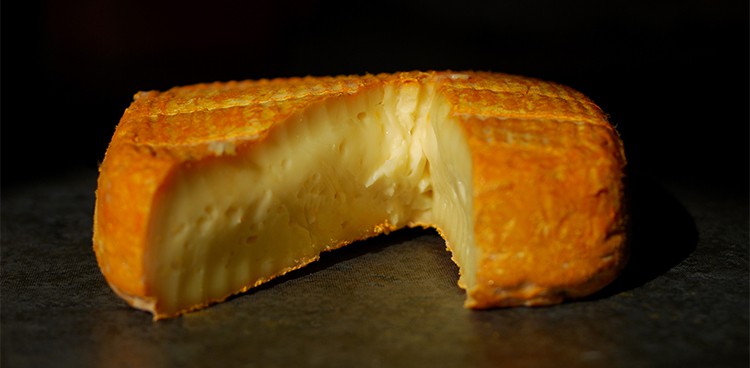
Intern Gabrielle Roman looks into what makes French cheeses tick for her blog series, Bon Fromage. Meant to answer any questions you might have but were afraid to ask about cheese made from the country famous for fromage, each post will focus on a specific cheese and take a deep dive into its history and production. Take the plunge and demystify the world of French cheese. If you missed it, last week’s post introduced the series and covered the famous Roquefort.
Before I cover anything else about Maroilles, I want to get the most pertinent information out of the way: how the heck do you pronounce this? As is common in French, not every letter is pronounced. Instead, it becomes two syllables and sounds something like mar-wahl. Although similar in sound, Maroilles is not a close cousin of the narwhal, adorable sea creature extraordinaire. Watch the following video for the proper pronunciation and try saying it out loud a few times yourself (warning: you will likely sound ridiculous).
Like a lot of cheese histories, the first appearance of Maroilles is a little slippery but it’s typically credited as beginning in 962 CE. Where you ask? Why, in the small town of Maroilles, of course! Located in the far north of France, the town of Maroilles bestowed its name onto the cheese it made, which is a running theme with French cheese history. The monks of Maroilles asked surrounding farmers to make cheese from their cow herds on June 24th (the feast day of Saint John the Baptist), and deliver the cheeses to the monastery on October 1st (the feast day of Saint Remi). The monks then distributed the cheese to the Champagne grape harvesters. In typical fashion, the monks are often credited with creating the cheese, and I guess by asking the farmers to provide for them, they were the brain trust behind the whole idea. But I’d like to offer some love to the farmers, too, and credit the birth of Maroilles as a group effort. Their efforts were so appreciated that during the Middle Ages, it was called La Merveille de Maroilles, or “The Marvel of Maroilles.”
The town threw a party in honor of its centuries of work in 1960, celebrating the 1,000th anniversary of Maroilles. The birth of this cheese literally stretches back a millennium. When Maroilles was being made in 960, the world’s first novel had not yet been written and wouldn’t be written for almost another fifty years. Maroilles predates novels! That is definitely worth celebrating.
Like most other French cheeses, Maroilles is purported to be the favorite of multiple French kings, including Philip II (reigned 1180–1223), Louis IX (1226–1270), Charles VI (1380–1422), and Francis I (1515–1547). If you’re keeping track at home, that now puts Charles VI in first place in the culture King Count, with two points for supporting Roquefort quality control and for loving Maroilles. (See the list at the bottom of the post for current standings.)
If this cheese has been around for so long and has been beloved by so many kings, there’s got to be a reason for it, right? Maroilles is an incredibly pungent cheese, but the taste is not as strong as the smells suggests: it’s mellow, earthy, and nutty with no hint of bitterness. The longer Maroilles ages, the smellier it gets, so some producers will put the cheese on shelves before it becomes too “aromatic.” Farmstead producers typically age Maroilles longer and let it develop into its fully stinky self, which also gives the flavors some time to mature.
Despite these differences in length of aging, you don’t have to worry about differences too much if your Maroilles is official Maroilles. Like Roquefort, Maroilles has AOC status, which means it must follow strict standards to be granted the name Maroilles. Any Maroilles you buy must be aged for a minimum of five weeks and a maximum of four months. Other regulations ensure Maroilles is always produced from cow’s milk (pasteurized or unpasteurized is fine) and is always square. The young cheese is shaped and put into square molds that must have an inner dimension of 12.5 to 13 centimeters, or about 5 inches. Make a Maroilles that’s 14 centimeters wide? Doesn’t count.

Photo Credit: Maroilles by Foodpictures | Shutterstock
In addition to the shape, Maroilles is distinctive for its rind. During the aging process the cheese is washed and brushed—without fungicides as per the AOC—and cheesemakers introduce our old friend bacteria. In this case, Brevibacterium linens turns the rind its signature orange-red color as it ages. The lines you see on the rind are thanks to the wire racks the cheese rests on during the production process.
The regulations for Maroilles do allow for different sizes and slightly different aging times. Any of the following are acceptable variations on the traditional 12.5 to 13 cm width and length:
- Sorbais – 12 to 12.5 inches, ripened at least four weeks
- Mignon – 11 to 11.5 inches, ripened at least three weeks
- Quart – 8 to 8.5 inches, ripened at least two weeks
I love this particular regulation because it shows just how strict AOC regulations can be. If your Maroilles is half an inch smaller than you intended, then it becomes Sorbais.
It just goes to show that you should never judge a cheese by its cover—or its smell.
culture King Count:
First place: Charles VI with 2 points (Roquefort and Maroilles)
(Tied for) Second: Philip II, Louis IX, Francis I with 1 point (Maroilles)
Feature Photo Credit: A french maroilles soft cheese on a slate surface by Mirabelle Pictures | Shutterstock




